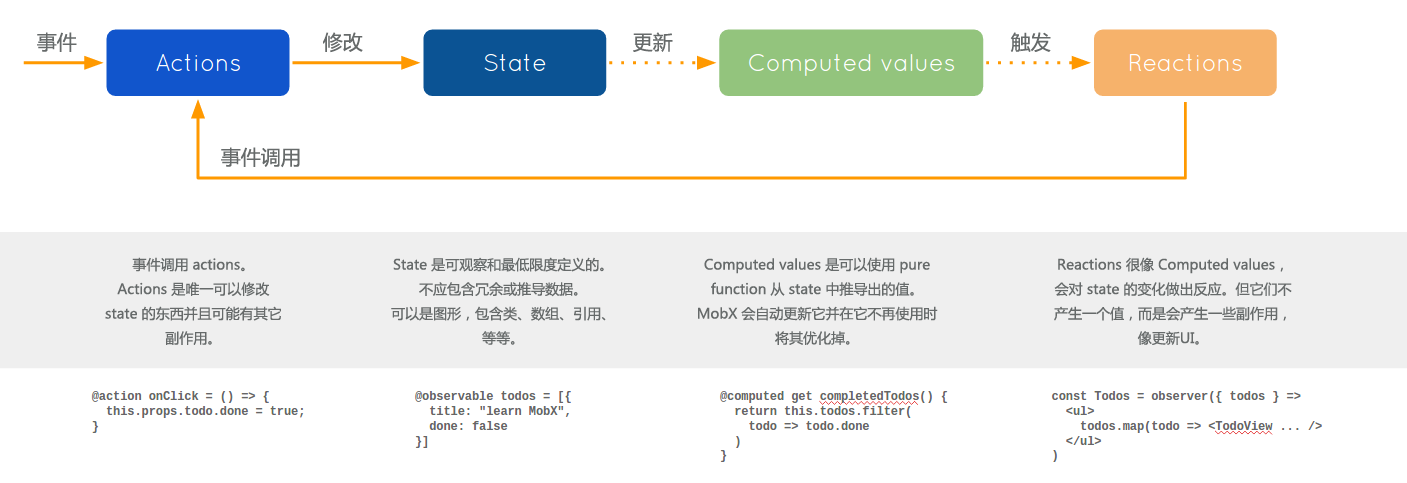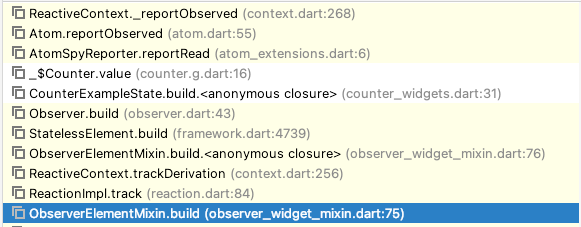简介:
概念

MobX 区分了以下几个应用中的概念:
State(状态)
状态 是驱动应用的数据。 通常有像待办事项列表这样的领域特定状态,还有像当前已选元素的视图状态。 记住,状态就像是有数据的excel表格。
Derivations(衍生)
任何 源自状态并且不会再有任何进一步的相互作用的东西就是衍生。 衍生以多种形式存在:
- 用户界面
- 衍生数据,比如剩下的待办事项的数量。
- 后端集成,比如把变化发送到服务器端。
MobX 区分了两种类型的衍生:
- Computed values(计算值) - 它们是永远可以使用纯函数(pure function)从当前可观察状态中衍生出的值。
- Reactions(反应) - Reactions 是当状态改变时需要自动发生的副作用。需要有一个桥梁来连接命令式编程(imperative programming)和响应式编程(reactive programming)。或者说得更明确一些,它们最终都需要实现I / O 操作。
刚开始使用 MobX 时,人们倾向于频繁的使用 reactions。 黄金法则: 如果你想创建一个基于当前状态的值时,请使用 computed。
回到excel表格这个比喻中来,公式是计算值的衍生。但对于用户来说,能看到屏幕给出的反应则需要部分重绘GUI。
Actions(动作)
动作 是任一一段可以改变状态的代码。用户事件、后端数据推送、预定事件、等等。 动作类似于用户在excel单元格中输入一个新的值。
在 MobX 中可以显式地定义动作,它可以帮你把代码组织的更清晰。 如果是在严格模式下使用 MobX的话,MobX 会强制只有在动作之中才可以修改状态。
原则
MobX 支持单向数据流,也就是动作改变状态,而状态的改变会更新所有受影响的视图。

当状态改变时,所有衍生都会进行原子级的自动更新。因此永远不可能观察到中间值。
所有衍生默认都是同步更新。这意味着例如动作可以在改变状态之后直接可以安全地检查计算值。
计算值 是延迟更新的。任何不在使用状态的计算值将不会更新,直到需要它进行副作用(I / O)操作时。 如果视图不再使用,那么它会自动被垃圾回收。
所有的计算值都应该是纯净的。它们不应该用来改变状态。
相关文章:
mobx官方文档:
https://cn.mobx.js org/refguide/action.html
https://mobx.netlify.app/api/reaction
原理:
https://takeroro.github.io/2020/06/30/mobX%20flutter%20%E6%95%B0%E6%8D%AE%E6%B5%81%E5%8A%A8/
https://juejin.cn/post/6844903860184563720
https://www.jianshu.com/p/a47d77f6371d
https://zhuanlan.zhihu.com/p/421675450
基本用法:
-
使用
Observer包裹需要刷新的UI组件。 -
创建可观察的
model -
使用命令自动生成.g文件
flutter pub run build_runner build
示例代码:
import 'package:flutter/material.dart';
import 'package:flutter_mobx/flutter_mobx.dart';import 'counter.dart';class CounterExample extends StatefulWidget {const CounterExample({Key? key}) : super(key: key);CounterExampleState createState() => CounterExampleState();
}class CounterExampleState extends State<CounterExample> {final Counter counter = Counter();Widget build(BuildContext context) => Scaffold(appBar: AppBar(backgroundColor: Colors.blue,title: const Text('MobX Counter'),),body: Center(child: Column(mainAxisAlignment: MainAxisAlignment.center,children: <Widget>[const Text('You have pushed the button this many times:',),Observer(builder: (_) => Text('${counter.value}',style: const TextStyle(fontSize: 40),)),],),),floatingActionButton: FloatingActionButton(onPressed: counter.increment,tooltip: 'Increment',child: const Icon(Icons.add),),);
}
// GENERATED CODE - DO NOT MODIFY BY HANDpart of 'counter.dart';// **************************************************************************
// StoreGenerator
// **************************************************************************// ignore_for_file: non_constant_identifier_names, unnecessary_brace_in_string_interps, unnecessary_lambdas, prefer_expression_function_bodies, lines_longer_than_80_chars, avoid_as, avoid_annotating_with_dynamicmixin _$Counter on _Counter, Store {final _$valueAtom = Atom(name: '_Counter.value');int get value {_$valueAtom.reportRead();return super.value;}set value(int value) {_$valueAtom.reportWrite(value, super.value, () {super.value = value;});}final _$_CounterActionController = ActionController(name: '_Counter');void increment() {final _$actionInfo =_$_CounterActionController.startAction(name: '_Counter.increment');try {return super.increment();} finally {_$_CounterActionController.endAction(_$actionInfo);}}String toString() {return '''
value: ${value}''';}
}
import 'package:mobx/mobx.dart';part 'counter.g.dart';class Counter = _Counter with _$Counter;abstract class _Counter with Store {int value = 0;void increment() {value++;}
}依赖:
dependencies:flutter:sdk: flutter# The following adds the Cupertino Icons font to your application.# Use with the CupertinoIcons class for iOS style icons.cupertino_icons: ^1.0.2mobx: ^2.0.6+1flutter_mobx: ^2.0.4dev_dependencies:flutter_test:sdk: flutterbuild_runner: ^2.1.0mobx_codegen: ^2.0.0
运行原理:
Observer组件初始化
首先父组件调用build,接着创建Observer组件,调用Observer组件的mount和build
Observer继承关系

Observer组件继承自StatelessObservderWidget
class Observer extends StatelessObserverWidget
StatelessObserverWidget调用了createElement方法
abstract class StatelessObserverWidget extends StatelessWidgetwith ObserverWidgetMixin {...StatelessObserverElement createElement() => StatelessObserverElement(this);
}
StatelessObserverElement混入了ObserverElementMixin类
class StatelessObserverElement extends StatelessElementwith ObserverElementMixin {
ObserverElementMixin继承自ComponentElement,ComponentElement继承自Element
mount方法
ObserverElementMixin复写了Element类的mount方法
element的mount方法的作用:将该元素添加到指定父节点的指定槽位的树中。当一个新创建的元素被添加到框架中时,框架调用这个函数
mount方法,在初始化的时候被调用。
mixin ObserverElementMixin on ComponentElement {...late ReactionImpl _reaction;...void mount(Element? parent, dynamic newSlot) {_reaction = _widget.createReaction(invalidate, onError: (e, _) {···}) as ReactionImpl;super.mount(parent, newSlot);}void invalidate() => markNeedsBuild();...
}
ObserverElementMixin调用了_widget.createReaction方法,用于_reaction初始化:
mixin ObserverWidgetMixin on Widget {...ReactiveContext getContext() => mainContext;/// A convenience method used for testing.Reaction createReaction(Function() onInvalidate, {Function(Object, Reaction)? onError,}) =>ReactionImpl(getContext(),onInvalidate,name: getName(),onError: onError,);...
}
_reaction初始化时传入的invalidate如下,该方法是状态变换时widget的行为,就是重新绘制
void invalidate() => markNeedsBuild();
ReactionImpl类
每个ObserverElementMixin都持有一个ReactionImpl 类型的_reaction,
可以这么理解,_reaction等同于一个Observer组件
ReactionImpl类的继承关系如下:

Derivation类的代码如下:
abstract class Derivation {String get name;late Set<Atom> _observables;Set<Atom>? _newObservables;MobXCaughtException? _errorValue;MobXCaughtException? get errorValue;late DerivationState _dependenciesState;void _onBecomeStale();// ignore: unused_elementvoid _suspend();
}
每个derivation类都有自己的name,_observables监听者集合, _dependenciesState状态
我们来简单看下mobx里的几种状态(DerivationState)
enum DerivationState {// 在运行之前或(在批处理之外并且没有被观察到)此时派生没有保存任何关于依赖树的数据notTracking,// 自上次计算以来没有改变浅依赖不会重新计算推导这就是使 mobx 快速的原因upToDate,// 一些深度依赖改变了,但是不知道浅依赖改变是否需要先检查 UP_TO_DATE 或 POSSIBLY_STALE 目前只有 Computed 会传播 POSSIBLY_STALEpossiblyStaleß,// 自上次计算以来,浅层依赖关系发生了变化,并且在下次需要时需要重新计算推导。stale
}
ReactiveContext类
MobX 的主要Context。 所有反应性操作和观察都在发生在这个Context中。 单例。
主要的属性和方法如下:
class ReactiveContext {ReactiveContext({ReactiveConfig? config}) {this.config = config ?? ReactiveConfig.main;}late ReactiveConfig _config;_ReactiveState _state = _ReactiveState();void startBatch() {···}void endBatch() {···}Derivation? _startTracking(Derivation derivation) {···}void _endTracking(Derivation currentDerivation, Derivation? prevDerivation) {···}T? trackDerivation<T>(Derivation d, T Function() fn) {···}void _reportObserved(Atom atom) {···}void _bindDependencies(Derivation derivation) {···}void runReactions() {···}void _runReactionsInternal() {···}}
_ReactiveState类
简单介绍一下context类里的state
class _ReactiveState {/// 当前批次深度。 这用于跟踪 `transaction` / `action` 的深度。/// 当批处理结束时,我们执行所有的 [pendingReactions]int batch = 0;/// 跟踪当前执行的Derivation(reactions or computeds)。/// 这里使用的 Observables 链接到这个Derivation。Derivation? trackingDerivation;/// Are we in middle of executing the [pendingReactions].bool isRunningReactions = false;···
}
build方法:
初始化时build调用了两次,调用super.build调用一次,接着自身又调用一次
在mount方法执行完成之后,ObserverElementMixin重写的build方法被调用。
mixin ObserverElementMixin on ComponentElement {···Widget build() {late final Widget built;reaction.track(() {built = super.build();});···return built;}···
}
ObserverElementMixin的build方法,调用了ReactionImpl的track方法
ReactionImpl类里的track方法主要调用了ReactiveContext 里的三个方法
void track(void Function() fn) {_context.startBatch();···_context.trackDerivation(this, fn);···_context.endBatch();}
startBatch方法:
void startBatch() {_state.batch++;}
trackDerivation方法:
trackDerivation方法有两个参数,一个是ReactionImpl对象的内存地址,一个是Widget的build函数。
T? trackDerivation<T>(Derivation d, T Function() fn) {final prevDerivation = _startTracking(d);T? result;···result = fn();···_endTracking(d, prevDerivation);return result;}
trackDerivation方法内部主要调用了两个方法_startTracking和 _endTracking
-
_startTracking方法:_startTracking将当前ReactiveContext持有的_ReactivState里的trackingDerivation设置为当前ReactionImplReactiveContext持有的_ReactivState里的trackingDerivation个人理解就是记录当前执行任务的ReactionImpl首先
_startTracking调用_resetDerivationStateDerivation? _startTracking(Derivation derivation) {final prevDerivation = _state.trackingDerivation;_state.trackingDerivation = derivation;_resetDerivationState(derivation);derivation._newObservables = {};return prevDerivation; }在
_resetDerivationState方法里更改了状态,将当前ReactionImpl的_dependenciesState状态变为upToDate,将当前ReactionImpl的_observables里的``Atom的_lowestObserverState状态变为upToDate`void _resetDerivationState(Derivation d) {if (d._dependenciesState == DerivationState.upToDate) {return;}d._dependenciesState = DerivationState.upToDate;for (final obs in d._observables) {obs._lowestObserverState = DerivationState.upToDate;}} -
result = fn():result = fn()调用了fn()方法() {built = super.build();}调用了父组件的
build,给Observer组件的built方法赋值父组件
build后就会调用CounterExampleState组件的build,而在CounterExampleState组件里使用了CounterBase的值,所以在这里就会走到CounterBase下的get value方法里int get value {_$valueAtom.reportRead();return super.value; }他将
atom添加到ReactionImpl维护的_newObservables里
主要看一下第一个方法
_reportObserved。void _reportObserved(Atom atom) {final derivation = _state.trackingDerivation;if (derivation != null) {derivation._newObservables!.add(atom);}}可以这样理解,当前的
element一旦使用了atom维护的value(会调用_$Counter.getValue),这一步就会把对应的atom加入到element下的ReactionImpl维护的_newObservables里接着回到
_context.trackDerivation方法里,fn执行完成之后,执行_endTracking -
_endTracking方法:_endTracking将当前ReactiveContext持有的_ReactivState里的trackingDerivation设置为prevDerivationvoid _endTracking(Derivation currentDerivation, Derivation? prevDerivation) {_state.trackingDerivation = prevDerivation;_bindDependencies(currentDerivation); }_bindDependencies代码如下,ReactionImpl类维护了两个_observables集合将当前
ReactionImpl加入到Atom类型的observable集合的每一个子元素Atom中,只保留活跃的Atom,删除旧的Atomvoid _bindDependencies(Derivation derivation) {final staleObservables =derivation._observables.difference(derivation._newObservables!);final newObservables =derivation._newObservables!.difference(derivation._observables);var lowestNewDerivationState = DerivationState.upToDate;// Add newly found observablesfor (final observable in newObservables) {observable._addObserver(derivation);···}// Remove previous observablesfor (final ob in staleObservables) {ob._removeObserver(derivation);}···derivation.._observables = derivation._newObservables!.._newObservables = {}; // No need for newObservables beyond this point}
endBatch方法:
endBatch会判断context的state是否还有任务,当没有任务的时候,调用runReactions。
void endBatch() {if (--_state.batch == 0) {runReactions();···
}
如果还有待办batch,或者已经正在执行重绘就返回
void runReactions() {if (_state.batch > 0 || _state.isRunningReactions) {return;}_runReactionsInternal();
}void _runReactionsInternal() {...//context里_state的待办Reactions集合,也就是需要刷新的Observerfinal allReactions = _state.pendingReactions;final remainingReactions = allReactions.toList(growable: false);//清空待办allReactions.clear();for (final reaction in remainingReactions) {//reaction._run();}//清空待办_state..pendingReactions = []..isRunningReactions = false;
}
run里主要执行_onInvalidate()
void _run() {_context.startBatch();_onInvalidate();_context.endBatch();}
还记得之前在ReactionImpl类初始化时介绍的吗
_reaction初始化时传入的invalidate如下,该方法是状态变换时widget的行为,就是重新绘制
void invalidate() => markNeedsBuild();
完整的更改value过程:
在阅读完整过程之前,先简单的介绍一下action
part of '../core.dart';class Action {/// Creates an action that encapsulates all the mutations happening on the/// observables.////// Wrapping mutations inside an action ensures the depending observers/// are only notified when the action completes. This is useful to silent the notifications/// when several observables are being changed together. You will want to run your/// reactions only when all the mutations complete. This also helps in keeping/// the state of your application consistent.////// You can give a debug-friendly [name] to identify the action.////// ```/// var x = Observable(10);/// var y = Observable(20);/// var total = Observable(0);////// autorun((){/// print('x = ${x}, y = ${y}, total = ${total}');/// });////// var totalUp = Action((){/// x.value++;/// y.value++;////// total.value = x.value + y.value;/// }, name: 'adder');/// ```/// Even though we are changing 3 observables (`x`, `y` and `total`), the [autorun()]/// is only executed once. This is the benefit of action. It batches up all the change/// notifications and propagates them only after the completion of the action. Actions/// can also be nested inside, in which case the change notification will propagate when/// the top-level action completes.factory Action(Function fn, {ReactiveContext? context, String? name}) =>Action._(context ?? mainContext, fn, name: name);Action._(ReactiveContext context, this._fn, {String? name}): _controller = ActionController(context: context, name: name);String get name => _controller.name;final ActionController _controller;final Function _fn;dynamic call([List args = const [], Map<String, dynamic>? namedArgs]) {final runInfo = _controller.startAction();try {// Invoke the actual functionif (namedArgs == null) {return Function.apply(_fn, args);} else {// Convert to symbol-based named-argsfinal namedSymbolArgs =namedArgs.map((key, value) => MapEntry(Symbol(key), value));return Function.apply(_fn, args, namedSymbolArgs);}} finally {_controller.endAction(runInfo);}}
}/// `ActionController` is used to define the start/end boundaries of code which
/// should be wrapped inside an action. This ensures all observable mutations are neatly
/// encapsulated.
///
/// You would rarely need to use this directly. This is primarily meant for the **`mobx_codegen`** package.
///
class ActionController {ActionController({ReactiveContext? context, String? name}): this._(context ?? mainContext, name: name);ActionController._(this._context, {String? name}): name = name ?? _context.nameFor('Action');final ReactiveContext _context;final String name;ActionRunInfo startAction({String? name}) {final reportingName = name ?? this.name;_context.spyReport(ActionSpyEvent(name: reportingName));final startTime = _context.isSpyEnabled ? DateTime.now() : null;final prevDerivation = _context.startUntracked();_context.startBatch();final prevAllowStateChanges = _context.startAllowStateChanges(allow: true);return ActionRunInfo(prevDerivation: prevDerivation,prevAllowStateChanges: prevAllowStateChanges,name: reportingName,startTime: startTime,);}void endAction(ActionRunInfo info) {final duration = _context.isSpyEnabled? DateTime.now().difference(info.startTime!): Duration.zero;_context.spyReport(EndedSpyEvent(type: 'action', name: info.name, duration: duration),);// ignore: cascade_invocations_context..endAllowStateChanges(allow: info.prevAllowStateChanges)..endBatch()..endUntracked(info.prevDerivation);}
}class ActionRunInfo {ActionRunInfo({required this.name,this.startTime,this.prevDerivation,this.prevAllowStateChanges = true,});final Derivation? prevDerivation;final bool prevAllowStateChanges;final String name;final DateTime? startTime;
}
action,创建一个封装所有发生在可观察对象上的变化的action。在action中包装变化可确保仅在action完成时通知依赖的观察者。当多个可观察对象一起更改时,这对于使通知静音很有用。只有在所有变化完成后,您才会想要运行您的反应。这也有助于保持应用程序状态的一致性。
首先是点击事件increment(),可以看到开启了一个action
void increment() {final _$actionInfo = _$CounterBaseActionController.startAction(name: 'CounterBase.increment');try {return super.increment();} finally {_$CounterBaseActionController.endAction(_$actionInfo);}}
startAction()主要调用了_context.startBatch();
ActionRunInfo startAction({String? name}) {final reportingName = name ?? this.name;_context.spyReport(ActionSpyEvent(name: reportingName));final startTime = _context.isSpyEnabled ? DateTime.now() : null;final prevDerivation = _context.startUntracked();_context.startBatch();final prevAllowStateChanges = _context.startAllowStateChanges(allow: true);return ActionRunInfo(prevDerivation: prevDerivation,prevAllowStateChanges: prevAllowStateChanges,name: reportingName,startTime: startTime,);
}
ReactiveContext下的startBatch,该state为Context持有的_ReactiveState
void startBatch() {_state.batch++;
}
接下来调用set value方法
set value(int value) {_$valueAtom.reportWrite(value, super.value, () {super.value = value;});
}
存值的时候调用了reportWrite方法
void reportWrite<T>(T newValue, T oldValuße, void Function() setNewValue) {context.spyReport(ObservableValueSpyEvent(this,newValue: newValue, oldValue: oldValue, name: name));final actionName = context.isSpyEnabled ? '${name}_set' : name;// ignore: cascade_invocationscontext.conditionallyRunInAction(() {setNewValue();reportChanged();}, this, name: actionName);// ignore: cascade_invocationscontext.spyReport(EndedSpyEvent(type: 'observable', name: name));}
conditionallyRunInAction方法在第一次运行的时候isWithinBatch是true,没有开启新的action而是直接开始执行fn()
void conditionallyRunInAction(void Function() fn, Atom atom,{String? name, ActionController? actionController}) {if (isWithinBatch) {enforceWritePolicy(atom);fn();} else {final controller = actionController ??ActionController(context: this, name: name ?? nameFor('conditionallyRunInAction'));final runInfo = controller.startAction();try {enforceWritePolicy(atom);fn();} finally {controller.endAction(runInfo);}}
}
执行fn()也就是 setNewValue()和reportChanged(),调用reportChanged
void reportChanged() {_context..startBatch()..propagateChanged(this)..endBatch();}
首先是ReactiveContext下的startBatch,该state为Context持有的_ReactiveState
void startBatch() {_state.batch++;
}
接着调用propagateChanged方法,将所有订阅该atom的element下的ReactionImpl的状态都变为需要更新。
void propagateChanged(Atom atom) {if (atom._lowestObserverState == DerivationState.stale) {return;}atom._lowestObserverState = DerivationState.stale;for (final observer in atom._observers) {if (observer._dependenciesState == DerivationState.upToDate) {observer._onBecomeStale();}observer._dependenciesState = DerivationState.stale;}}
当observer._dependenciesState == DerivationState.upToDate为真时, 执行 onBecomeStale
void _onBecomeStale() {schedule();
}
void schedule() {if (_isScheduled) {return;}_isScheduled = true;_context..addPendingReaction(this)..runReactions();
}
在第一次调用时,batch的数量大于0,因为上面开启了一次action,调用了startBatch,并且reportChanged调用了startBatch
void runReactions() {if (_state.batch > 0 || _state.isRunningReactions) {return;}_runReactionsInternal();
}
然后来到endBatch(),endBatch首先将_state.batch进行--操作,代表着执行完了一个batch,只有所有batch都执行完成时,才会运行runReactions。
先简单看下_ReactiveState的batch
class _ReactiveState {
/// 当前批次深度。 这用于跟踪 `transaction` / `action` 的深度。/// 当批处理结束时,我们执行所有的 [pendingReactions]int batch = 0;
void endBatch() {if (--_state.batch == 0) {runReactions();for (var i = 0; i < _state.pendingUnobservations.length; i++) {final ob = _state.pendingUnobservations[i].._isPendingUnobservation = false;if (ob._observers.isEmpty) {if (ob._isBeingObserved) {// if this observable had reactive observers, trigger the hooksob.._isBeingObserved = false.._notifyOnBecomeUnobserved();}if (ob is Computed) {ob._suspend();}}}_state.pendingUnobservations = [];}
}
运行到这里内部的batch已经执行完了,接下来会执行外部action的endAction,再次贴一下代码
void increment() {final _$actionInfo = _$CounterBaseActionController.startAction(name: 'CounterBase.increment');try {return super.increment();} finally {_$CounterBaseActionController.endAction(_$actionInfo);//这里被调用了}
}
endAction代码如下
void endAction(ActionRunInfo info) {final duration = _context.isSpyEnabled? DateTime.now().difference(info.startTime!): Duration.zero;_context.spyReport(EndedSpyEvent(type: 'action', name: info.name, duration: duration),);// ignore: cascade_invocations_context..endAllowStateChanges(allow: info.prevAllowStateChanges)..endBatch()..endUntracked(info.prevDerivation);}
再次进入endBatch()
void endBatch() {if (--_state.batch == 0) {runReactions();for (var i = 0; i < _state.pendingUnobservations.length; i++) {final ob = _state.pendingUnobservations[i].._isPendingUnobservation = false;if (ob._observers.isEmpty) {if (ob._isBeingObserved) {// if this observable had reactive observers, trigger the hooksob.._isBeingObserved = false.._notifyOnBecomeUnobserved();}if (ob is Computed) {ob._suspend();}}}_state.pendingUnobservations = [];}
}
这次所有的batch执行完了,batch已经为0
void runReactions() {if (_state.batch > 0 || _state.isRunningReactions) {return;}_runReactionsInternal();
}
_runReactionsInternal主要执行 reaction. _run();
void _runReactionsInternal() {_state.isRunningReactions = true;var iterations = 0;final allReactions = _state.pendingReactions;// While running reactions, new reactions might be triggered.// Hence we work with two variables and check whether// we converge to no remaining reactions after a while.while (allReactions.isNotEmpty) {if (++iterations == config.maxIterations) {final failingReaction = allReactions[0];// Resetting ensures we have no bad-state left_resetState();throw MobXCyclicReactionException("Reaction doesn't converge to a stable state after ${config.maxIterations} iterations. Probably there is a cycle in the reactive function: $failingReaction");}final remainingReactions = allReactions.toList(growable: false);allReactions.clear();for (final reaction in remainingReactions) {reaction._run();}}_state..pendingReactions = []..isRunningReactions = false;
}
run里主要执行_onInvalidate()
void _run() {if (_isDisposed) {return;}_context.startBatch();_isScheduled = false;if (_context._shouldCompute(this)) {try {_onInvalidate();} on Object catch (e, s) {// Note: "on Object" accounts for both Error and Exception_errorValue = MobXCaughtException(e, stackTrace: s);_reportException(_errorValue!);}}_context.endBatch();
}
创建Atom
完整代码:
class Atom {/// Creates a simple Atom for tracking its usage in a reactive context. This is useful when/// you don't need the value but instead a way of knowing when it becomes active and inactive/// in a reaction.////// Use the [onObserved] and [onUnobserved] handlers to know when the atom is active and inactive/// respectively. Use a debug [name] to identify easily.factory Atom({String? name,Function()? onObserved,Function()? onUnobserved,ReactiveContext? context}) =>Atom._(context ?? mainContext,name: name, onObserved: onObserved, onUnobserved: onUnobserved);Atom._(this._context,{String? name, Function()? onObserved, Function()? onUnobserved}): name = name ?? _context.nameFor('Atom') {if (onObserved != null) {onBecomeObserved(onObserved);}if (onUnobserved != null) {onBecomeUnobserved(onUnobserved);}}final ReactiveContext _context;ReactiveContext get context => _context;final String name;// ignore: prefer_final_fieldsbool _isPendingUnobservation = false;DerivationState _lowestObserverState = DerivationState.notTracking;// ignore: prefer_final_fieldsbool _isBeingObserved = false;final Set<Derivation> _observers = {};bool get hasObservers => _observers.isNotEmpty;final Map<_ListenerKind, Set<void Function()>?> _observationListeners = {};void reportObserved() {_context._reportObserved(this);}void reportChanged() {_context..startBatch()..propagateChanged(this)..endBatch();}void _addObserver(Derivation d) {_observers.add(d);if (_lowestObserverState.index > d._dependenciesState.index) {_lowestObserverState = d._dependenciesState;}}void _removeObserver(Derivation d) {_observers.remove(d);if (_observers.isEmpty) {_context._enqueueForUnobservation(this);}}void _notifyOnBecomeObserved() {final listeners = _observationListeners[_ListenerKind.onBecomeObserved];listeners?.forEach(_notifyListener);}static void _notifyListener(void Function() listener) => listener();void _notifyOnBecomeUnobserved() {final listeners = _observationListeners[_ListenerKind.onBecomeUnobserved];listeners?.forEach(_notifyListener);}void Function() onBecomeObserved(void Function() fn) =>_addListener(_ListenerKind.onBecomeObserved, fn);void Function() onBecomeUnobserved(void Function() fn) =>_addListener(_ListenerKind.onBecomeUnobserved, fn);void Function() _addListener(_ListenerKind kind, void Function() fn) {if (_observationListeners[kind] == null) {_observationListeners[kind] = {}..add(fn);} else {_observationListeners[kind]!.add(fn);}return () {final listeners = _observationListeners[kind];if (listeners == null) {return;}listeners.removeWhere((f) => f == fn);if (listeners.isEmpty) {_observationListeners[kind] = null;}};}
}
创建Atom
final _$valueAtom = Atom(name: 'CounterBase.value');
构造如下:
Atom._(context ?? mainContext,name: name, onObserved: onObserved, onUnobserved: onUnobserved);
mainContext定义如下:
final ReactiveContext mainContext = createContext(config: ReactiveConfig.main);ReactiveContext createContext({ReactiveConfig? config}) =>ReactiveContext(config: config);
维护了一个_observersset,监听者合集。
final Set<Derivation> _observers = {};



![[C++] STL数据结构小结](http://pic.xiahunao.cn/nshx/[C++] STL数据结构小结)



